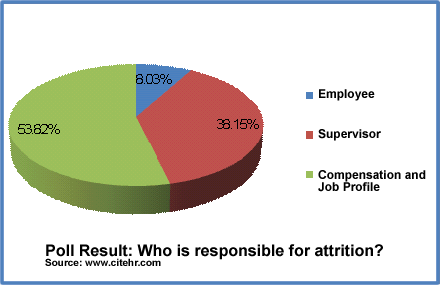HR Heads are worried about employees leaving their organizations. Not only is it costly to lose trained employees but their replacements are not easy to come by. Hence the HR strives hard to keep attrition at the minimum.
Greg Weiss, an HR consultant and principal of Human Management, in extensive interviews with HR directors at 30 companies found that most companies have little real understanding of why employees leave. Source: Article on www.zdnet.com.au
I came across a public poll that was conducted at Cite HR (a popular meeting point for HR professionals) to find the opinion of the HR community on the reasons for attrition. The poll was titled ‘Who will held responsible for attrition?’ and participants have to chose an option responsible for attrition. The options were:
1. Employee
2. Supervisor or Line Manager
3. Compensation & Job Profile
The Poll Results: The HR community welcomed the poll and a large number of them participated. The results of the poll on a specific date were as follows (The poll still continues and numbers of voters have increased, however, the result remains more or less same).
Analysis of the poll results:
The results of the poll are very interesting and can provide deep insights into why attrition happens and what may help solve it.
Employee as a reason for attrition:
Only 8% HR professionals felt that employees leave organizations on their own. Except in a few cases such as personal reasons, family issues, location preference, company brand and peer relationships, employees are not self-motivated to leave the company they are working in.
Nevertheless it is important to find out common causes for employee initiated exits where supervisors and/or Job Profile / compensation are not the cause.
Employee Satisfaction surveys are the ways to identify such areas of dissatisfaction, one of which may be HR policy guidelines of the company. If you conduct these surveys on a regular basis and map their results to exit interviews; new findings may identify critical gaps in how the employees perceive your policies. Very important trends can be identified by regular surveys conducted over the period of 1 – 2 years. These can also help define future HR guidelines with minimal disruption and dissatisfaction.
There are a number of survey tools available in the marketplace and one such popular tool is the Employee Satisfaction Survey available in Empxtrack. It helps integrate various aspects of HR to give more meaningful results.
Supervisor or Line Manager as a cause of attrition:
A large majority of HR professionals polled that immediate managers are a bigger reason for attrition. It confirms Wayne Hochwarter [an associate professor of management in the College of Business at Florida State University] theory that “Employees don’t leave their job or company, they leave their manager”.
Meeting employees’ expectations is a difficult task, and most managers cannot do it effectively and consistently. ‘Satisfying employee needs’ often gets lower priority in a manager’s quadrant of activities. Further managers do not have appropriate tools to manage employee related tasks and this leads to further dissatisfaction.
HR should continually train managers in handling employee expectations and provide them with tools to manage tasks related to their teams. An online Manager Services solution allows a manager to constantly counsel employees, manage their career growth and aspirations and track their achievements.
HR should also be able to track changes in employee performance rating, gaps between employee and manager performance, sudden increase in paid-time-off and should be prepared to act quickly if any visible trends are evident.
Compensation and Job Profile:
HR Managers voted unanimously that ‘Compensation and Job Profile’ are the primary cause of attrition.
With a war for talent, disparity in the compensation packages is bound to occur and a mis-matched job profile increases the likelihood of an exit.
The responsibility for compensation policy and enriching the job profile lies on the senior management. However, balancing P&L and employee compensation shall always be a nightmare for them given the high cost of talented employees.
Every company wants to become the ‘best paying employer’, but market forces, tough competition and a slow economy dictate otherwise. A fair and transparent compensation policy can still be adopted where each employee gets his/ her dues based on company, team & individual performance.
If your employees are convinced that they are compensated in direct proportion to their productivity, you have won half the battle. The other half is won when each individual is assigned SMART (Specific, Measurable, Achievable, Reviewable and Time Based) goals and you can cascade these from organization objectives.
When all employees work on goals that are aligned to the company objectives and there is a fair and transparent system to capture employee performance, the likelihood of a satisfied and motivated workforce increases and Compensation or Job Profile become manageable causes.
Empxtrack Goal Setting module allows you to achieve this effectively and the Appraisal module automatically captures achievements to allow a transparent system of rewards based on performance.
You may also like to read a related article “Why good employees leave your organization?“
Best wishes on retaining a satisfied and productive workforce. If you have any feedback on our thoughts, ideas or products please contact us




Thanks , I have just been searching for info approximately this subject for a long time and yours is the best I have discovered so far. But, what about the bottom line? Are you certain about the source? Peter